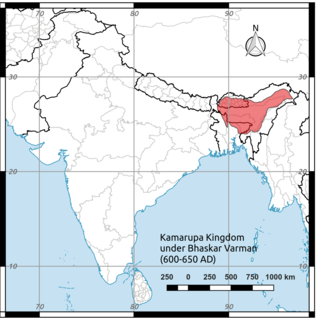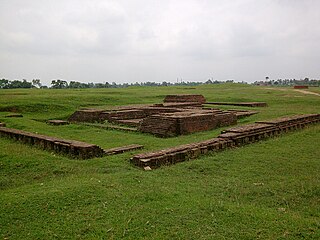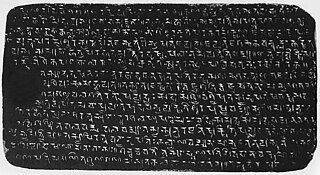Related Research Articles

Shashanka was the first independent king of a unified polity in the Bengal region, called the Gauda Kingdom and is a major figure in Bengali history. He reigned in the 7th century, some historians place his rule between circa 600 CE and 636/7 CE, whereas other sources place his reign between 590 and 625 CE.

Kamarupa, an early state during the Classical period on the Indian subcontinent, was the first historical kingdom of Assam.

The Varman dynasty (350–650) was the first historical dynasty of the Kamarupa kingdom. It was established by Pushyavarman, a contemporary of Samudragupta. The earlier Varmans were subordinates of the Gupta Empire, but as the power of the Guptas waned, Mahendravarman (470–494) performed two horse sacrifices and the status of Kamarupa as independent state remained umimpaired. According to the Allahabad Prasasti, the ruler of Kamarupa was a frontier ruler (Pratyanta-nrpatis) of the great Gupta emperor.

The Mlechchha dynasty ruled Kamarupa from their capital at Harruppesvar in present-day Tezpur, Assam, after the fall of the Varman dynasty. According to historical records, there were twenty one rulers in this dynasty, but the line is obscure and names of some intervening rulers are not known. Like all other Kamarupa dynasties a semi-mythical lineage from Narakasura was constructed to accord legitimacy to their rule. The Mlechchha dynasty in Kamarupa was followed by the Pala kings. The dynasty is unrelated to the previous Varman dynasty.

Beanibazar is an upazila (sub-district) of Sylhet District in northeastern Bangladesh, part of the Sylhet Division. The area is the successor of the territory of Panchakhanda, formerly ruled by the aristocratic Pal family.
Indian copper plate inscriptions are historical legal records engraved on copper plates in India.

Bhaskaravarman (600–650), the last of the Varman dynasty, was king of medieval Kamarupa. After being captured by the Gauda king during the reign of his father, he was able to re-establish the rule of the Varman's. He made political alliances with Harshavardhana of Thaneswar, against the alliance of the Gauda and East Malwa. He was visited by Xuanzang and Wang Xuance, the envoy of the Tang dynasty who have left accounts of the king and the kingdom.

Karnasuvarna or Karnasubarna was an ancient city, located in the present day Berhampore CD block in the Berhampore subdivision of Murshidabad district, West Bengal, India.

Kamrupi Brahmins, also known as Kamarupi Brahmana and Kamrupi Bamon; are those brahmins who claimed their descent from the Kanauji Brahmins and Maithili Brahmins who settled in Kamarupa. They brought with them different Hindu epics and became the torch-bearers of Indo-Aryan culture in the region.

Pushyavarman was the first historical ruler of Kamarupa (Assam) in eastern India, who established the Varman dynasty in 350 AD.

The earliest Indo-Aryan migration to Assam is estimated to have occurred between the 2nd century BCE and 1st century CE—not earlier than 500 BCE.The earliest epigraphic record suggests that the Indo-Aryan migration began latest by the middle of the 4th century CE. They came from the Gangetic Plains into a region already inhabited by people who spoke Austroasiatic and Tibeto-Burman languages.

Susthitavarman (590-595) was a ruler of Kamarupa. He was a son of Sthitavarman and Queen Nayanadevi.

Supratisthitavarman ruled Kamarupa from the Varman dynasty for the period 595–600. He was son of King Susthitavarman and Queen Shyamadevi.

Ratna Pala was the son of Brahma Pala in Pala Dynasty (900–1100) of Kamarupa Kingdom. His queen's name was Durlabha. He was succeeded by Indra Pala.

Dharma Pala (1035–1060) was ruler of Pala Dynasty (900–1100) of Kamarupa Kingdom.

Kamarupa – Late to end period was a period of Kamarupa kingdom from founding of Pala Dynasty by Brahma Pala to last ruler of dynasty Jaya Pala.
Avantivarman is believed to be the last king of the Varman dynasty of Kamarupa in present-day North-East India.

The Nidhanpur copperplate inscription of the 7th-century Kamarupa king Bhaskaravarman gives a detailed account of land grants given to Brahmins. It records land grants to more than two hundred vaidika brahmanas belonging to 56 gotras. The copper plates were found mostly in Panchakhanda pargana where, according to historians, the actual granted lands were located. This Sanskrit inscription contains the names of donees which are more than two hundred in numbers.

Kamarupi script was the script used in ancient Kamarupa from as early as 5th century to 13th century, from which the modern Assamese script eventually evolved. In the development of the Assamese script, this phase was followed by the medieval and then by the modern Assamese scripts.
The Dubi copperplate inscription are the inscriptions of a grant issued by Bhaskaravarman of Kamarupa. This is the earliest of all copper plate grants issued by Kamarupa kings discovered so far. This was an issue after an earlier charter, issued by Bhutivarman, was destroyed. There are five copper plates in this collection, with seventy-six verses in Sanskrit, written in the eastern variety of North Indian alphabet prevalent in the sixth and seventh centuries. All six plates in this grant were first discovered around 1950 during digging near a Siva temple in Dubi village about three miles from the Pathsala railway station, Kamrup district, Assam; but the sixth plate was irrecoverably destroyed soon after discovery. These plates are currently in the Assam State Museum. This plate was issued before the Nidhanpur copperplate inscription, during the earlier part of Bhaskkaravarman's reign.